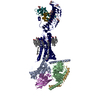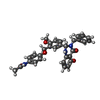+ Open data
Open data
- Basic information
Basic information
| Entry | Database: PDB / ID: 7xw6 | ||||||
|---|---|---|---|---|---|---|---|
| Title | TSHR-Gs-M22 antibody-ML109 complex | ||||||
 Components Components |
| ||||||
 Keywords Keywords | MEMBRANE PROTEIN / thyroid-stimulating hormone / thyroid-stimulating hormone receptor / THS / THSR / GPCR / Gs / ML-109 / M22 / scFv | ||||||
| Function / homology |  Function and homology information Function and homology informationthyroid-stimulating hormone signaling pathway / cellular response to glycoprotein / cellular response to thyrotropin-releasing hormone / thyroid-stimulating hormone receptor activity / Hormone ligand-binding receptors / G protein-coupled peptide receptor activity / G protein-coupled receptor signaling pathway, coupled to cyclic nucleotide second messenger / hormone-mediated signaling pathway / Olfactory Signaling Pathway / Activation of the phototransduction cascade ...thyroid-stimulating hormone signaling pathway / cellular response to glycoprotein / cellular response to thyrotropin-releasing hormone / thyroid-stimulating hormone receptor activity / Hormone ligand-binding receptors / G protein-coupled peptide receptor activity / G protein-coupled receptor signaling pathway, coupled to cyclic nucleotide second messenger / hormone-mediated signaling pathway / Olfactory Signaling Pathway / Activation of the phototransduction cascade / G beta:gamma signalling through PLC beta / Presynaptic function of Kainate receptors / Thromboxane signalling through TP receptor / G-protein activation / adenylate cyclase-activating G protein-coupled receptor signaling pathway / G protein-coupled acetylcholine receptor signaling pathway / Activation of G protein gated Potassium channels / Inhibition of voltage gated Ca2+ channels via Gbeta/gamma subunits / Prostacyclin signalling through prostacyclin receptor / Glucagon signaling in metabolic regulation / G beta:gamma signalling through CDC42 / ADP signalling through P2Y purinoceptor 12 / G beta:gamma signalling through BTK / Synthesis, secretion, and inactivation of Glucagon-like Peptide-1 (GLP-1) / Sensory perception of sweet, bitter, and umami (glutamate) taste / photoreceptor disc membrane / Adrenaline,noradrenaline inhibits insulin secretion / Glucagon-type ligand receptors / Vasopressin regulates renal water homeostasis via Aquaporins / G alpha (z) signalling events / cellular response to catecholamine stimulus / Glucagon-like Peptide-1 (GLP1) regulates insulin secretion / ADORA2B mediated anti-inflammatory cytokines production / sensory perception of taste / ADP signalling through P2Y purinoceptor 1 / adenylate cyclase-activating dopamine receptor signaling pathway / G beta:gamma signalling through PI3Kgamma / cellular response to prostaglandin E stimulus / Cooperation of PDCL (PhLP1) and TRiC/CCT in G-protein beta folding / GPER1 signaling / G-protein beta-subunit binding / Inactivation, recovery and regulation of the phototransduction cascade / heterotrimeric G-protein complex / G alpha (12/13) signalling events / extracellular vesicle / signaling receptor complex adaptor activity / Thrombin signalling through proteinase activated receptors (PARs) / GTPase binding / cell-cell signaling / retina development in camera-type eye / phospholipase C-activating G protein-coupled receptor signaling pathway / Ca2+ pathway / signaling receptor activity / positive regulation of cold-induced thermogenesis / G alpha (i) signalling events / fibroblast proliferation / G alpha (s) signalling events / G alpha (q) signalling events / basolateral plasma membrane / cell population proliferation / Ras protein signal transduction / Extra-nuclear estrogen signaling / cell surface receptor signaling pathway / receptor complex / G protein-coupled receptor signaling pathway / lysosomal membrane / GTPase activity / synapse / positive regulation of cell population proliferation / protein-containing complex binding / cell surface / signal transduction / extracellular exosome / membrane / plasma membrane / cytoplasm / cytosol Similarity search - Function | ||||||
| Biological species |  Homo sapiens (human) Homo sapiens (human) | ||||||
| Method | ELECTRON MICROSCOPY / single particle reconstruction / cryo EM / Resolution: 2.78 Å | ||||||
 Authors Authors | Duan, J. / Xu, P. / Luan, X. / Ji, Y. / Yuan, Q. / He, X. / Ye, J. / Cheng, X. / Jiang, H. / Zhang, S. ...Duan, J. / Xu, P. / Luan, X. / Ji, Y. / Yuan, Q. / He, X. / Ye, J. / Cheng, X. / Jiang, H. / Zhang, S. / Jiang, Y. / Xu, H.E. | ||||||
| Funding support |  China, 1items China, 1items
| ||||||
 Citation Citation |  Journal: Nature / Year: 2022 Journal: Nature / Year: 2022Title: Hormone- and antibody-mediated activation of the thyrotropin receptor. Authors: Jia Duan / Peiyu Xu / Xiaodong Luan / Yujie Ji / Xinheng He / Ning Song / Qingning Yuan / Ye Jin / Xi Cheng / Hualiang Jiang / Jie Zheng / Shuyang Zhang / Yi Jiang / H Eric Xu /   Abstract: Thyroid-stimulating hormone (TSH), through activation of its G-protein-coupled thyrotropin receptor (TSHR), controls the synthesis of thyroid hormone-an essential metabolic hormone. Aberrant ...Thyroid-stimulating hormone (TSH), through activation of its G-protein-coupled thyrotropin receptor (TSHR), controls the synthesis of thyroid hormone-an essential metabolic hormone. Aberrant signalling of TSHR by autoantibodies causes Graves' disease (hyperthyroidism) and hypothyroidism, both of which affect millions of patients worldwide. Here we report the active structures of TSHR with TSH and the activating autoantibody M22, both bound to the allosteric agonist ML-109, as well as an inactivated TSHR structure with the inhibitory antibody K1-70. Both TSH and M22 push the extracellular domain (ECD) of TSHR into an upright active conformation. By contrast, K1-70 blocks TSH binding and cannot push the ECD into the upright conformation. Comparisons of the active and inactivated structures of TSHR with those of the luteinizing hormone/choriogonadotropin receptor (LHCGR) reveal a universal activation mechanism of glycoprotein hormone receptors, in which a conserved ten-residue fragment (P10) from the hinge C-terminal loop mediates ECD interactions with the TSHR transmembrane domain. One notable feature is that there are more than 15 cholesterols surrounding TSHR, supporting its preferential location in lipid rafts. These structures also highlight a similar ECD-push mechanism for TSH and autoantibody M22 to activate TSHR, therefore providing the molecular basis for Graves' disease. | ||||||
| History |
|
- Structure visualization
Structure visualization
| Structure viewer | Molecule:  Molmil Molmil Jmol/JSmol Jmol/JSmol |
|---|
- Downloads & links
Downloads & links
- Download
Download
| PDBx/mmCIF format |  7xw6.cif.gz 7xw6.cif.gz | 616.8 KB | Display |  PDBx/mmCIF format PDBx/mmCIF format |
|---|---|---|---|---|
| PDB format |  pdb7xw6.ent.gz pdb7xw6.ent.gz | 523.5 KB | Display |  PDB format PDB format |
| PDBx/mmJSON format |  7xw6.json.gz 7xw6.json.gz | Tree view |  PDBx/mmJSON format PDBx/mmJSON format | |
| Others |  Other downloads Other downloads |
-Validation report
| Summary document |  7xw6_validation.pdf.gz 7xw6_validation.pdf.gz | 1.9 MB | Display |  wwPDB validaton report wwPDB validaton report |
|---|---|---|---|---|
| Full document |  7xw6_full_validation.pdf.gz 7xw6_full_validation.pdf.gz | 1.9 MB | Display | |
| Data in XML |  7xw6_validation.xml.gz 7xw6_validation.xml.gz | 53.1 KB | Display | |
| Data in CIF |  7xw6_validation.cif.gz 7xw6_validation.cif.gz | 79.6 KB | Display | |
| Arichive directory |  https://data.pdbj.org/pub/pdb/validation_reports/xw/7xw6 https://data.pdbj.org/pub/pdb/validation_reports/xw/7xw6 ftp://data.pdbj.org/pub/pdb/validation_reports/xw/7xw6 ftp://data.pdbj.org/pub/pdb/validation_reports/xw/7xw6 | HTTPS FTP |
-Related structure data
| Related structure data |  33492MC  7xw5C  7xw7C M: map data used to model this data C: citing same article ( |
|---|---|
| Similar structure data | Similarity search - Function & homology  F&H Search F&H Search |
- Links
Links
- Assembly
Assembly
| Deposited unit | 
|
|---|---|
| 1 |
|
- Components
Components
-Guanine nucleotide-binding protein ... , 3 types, 3 molecules ABG
| #1: Protein | Mass: 29068.906 Da / Num. of mol.: 1 Source method: isolated from a genetically manipulated source Source: (gene. exp.)  Homo sapiens (human) / Production host: Homo sapiens (human) / Production host:  |
|---|---|
| #2: Protein | Mass: 38613.176 Da / Num. of mol.: 1 Source method: isolated from a genetically manipulated source Source: (gene. exp.)  Homo sapiens (human) / Gene: GNB1 / Production host: Homo sapiens (human) / Gene: GNB1 / Production host:  |
| #3: Protein | Mass: 7861.143 Da / Num. of mol.: 1 Source method: isolated from a genetically manipulated source Source: (gene. exp.)  Homo sapiens (human) / Gene: GNG2 / Production host: Homo sapiens (human) / Gene: GNG2 / Production host:  |
-Protein , 2 types, 2 molecules NR
| #5: Protein | Mass: 14714.320 Da / Num. of mol.: 1 Source method: isolated from a genetically manipulated source Source: (gene. exp.)  Homo sapiens (human) / Production host: Homo sapiens (human) / Production host:  |
|---|---|
| #6: Protein | Mass: 79920.812 Da / Num. of mol.: 1 Source method: isolated from a genetically manipulated source Source: (gene. exp.)  Homo sapiens (human) / Gene: TSHR, LGR3 / Production host: Homo sapiens (human) / Gene: TSHR, LGR3 / Production host:  |
-Antibody , 2 types, 2 molecules LY
| #4: Antibody | Mass: 11970.064 Da / Num. of mol.: 1 Source method: isolated from a genetically manipulated source Source: (gene. exp.)   |
|---|---|
| #7: Antibody | Mass: 13399.967 Da / Num. of mol.: 1 Source method: isolated from a genetically manipulated source Source: (gene. exp.)  Homo sapiens (human) / Production host: Homo sapiens (human) / Production host:  |
-Sugars , 1 types, 4 molecules 
| #8: Sugar | ChemComp-NAG / |
|---|
-Non-polymers , 3 types, 23 molecules 




| #9: Chemical | ChemComp-CLR / #10: Chemical | ChemComp-PLM / #11: Chemical | ChemComp-HOI / ~{ | |
|---|
-Details
| Has ligand of interest | Y |
|---|
-Experimental details
-Experiment
| Experiment | Method: ELECTRON MICROSCOPY |
|---|---|
| EM experiment | Aggregation state: PARTICLE / 3D reconstruction method: single particle reconstruction |
- Sample preparation
Sample preparation
| Component | Name: The complex was assembled by co-expression. / Type: COMPLEX / Entity ID: #1-#7 / Source: RECOMBINANT |
|---|---|
| Source (natural) | Organism:  Homo sapiens (human) Homo sapiens (human) |
| Source (recombinant) | Organism:  |
| Buffer solution | pH: 7.4 |
| Specimen | Embedding applied: NO / Shadowing applied: NO / Staining applied: NO / Vitrification applied: YES |
| Vitrification | Cryogen name: ETHANE-PROPANE |
- Electron microscopy imaging
Electron microscopy imaging
| Experimental equipment |  Model: Titan Krios / Image courtesy: FEI Company |
|---|---|
| Microscopy | Model: FEI TITAN KRIOS |
| Electron gun | Electron source:  FIELD EMISSION GUN / Accelerating voltage: 300 kV / Illumination mode: FLOOD BEAM FIELD EMISSION GUN / Accelerating voltage: 300 kV / Illumination mode: FLOOD BEAM |
| Electron lens | Mode: BRIGHT FIELD / Nominal defocus max: 2200 nm / Nominal defocus min: 1200 nm |
| Image recording | Electron dose: 60 e/Å2 / Film or detector model: GATAN K3 (6k x 4k) |
- Processing
Processing
| CTF correction | Type: PHASE FLIPPING AND AMPLITUDE CORRECTION |
|---|---|
| 3D reconstruction | Resolution: 2.78 Å / Resolution method: FSC 0.143 CUT-OFF / Num. of particles: 455661 / Symmetry type: POINT |
 Movie
Movie Controller
Controller





 PDBj
PDBj





























